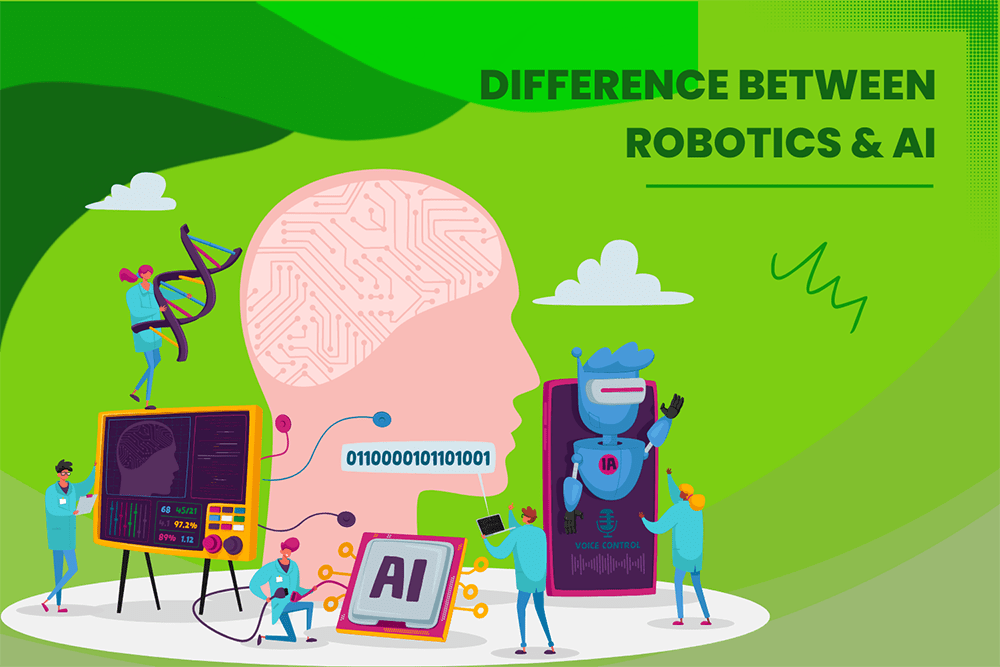The two fields about which the recent technology is getting a big rise is definitely Artificial Intelligence and Robotics.. But what exactly is Robotics and Artificial Intelligence? What is the difference between Artificial Intelligence and Robotics? In this article, we will see answers to all such questions and also check the key differences between Artificial Intelligence and Machine Learning.
What is Robotics?
Robotics is a branch of technology concerned with the design and implementation of robots. Robots are programmed machines that may behave autonomously or semi-autonomously. As a result, a planned, manufactured, and programmed robot may respond to orders or operate on its own utilising inbuilt memory.
Some of the fundamental features are as follows:
- Robots have a mechanical structure and are programmed to accomplish tasks.
- Electrical components in robots’ power and control various actuations.
- Minor computer programs are installed into robots to guarantee appropriate operation.
The primary goal of developing robots is to reduce the amount of labor that people must do. Robots may be programmed to do things like move, pick, package, perceive, and alter items. Robots can thereby relieve humans of tedious and repetitive duties.

What is Artificial Intelligence?
According to John McCarthy, the inventor of artificial intelligence, “AI is the science and engineering of creating intelligent devices, particularly clever computer programs.”
Artificial intelligence (AI) is a branch of computer science concerned with the creation of programs that mimic human intellect. AI is created by considerable research in psychology, mathematics, philosophy, sociology, neuron science, computer science, and biology.
The primary goal of artificial intelligence is to develop expert systems that can assist people and to enable robots to function with human-like intelligence.
A software can only answer a limited number of pre-programmed queries in the absence of AI. Changes to the system and structure of the entire programme are the only way to make modifications. In contrast, AI allows a software to answer frequently asked questions about any topic since it adapts and learns on its own. As a result, any necessary changes are easy to execute while having no overall impact on the programme.
AI’s primary functional areas include:
- Expert systems – to efficiently handle the digital world
- Natural language processing (NLP) – for social skills and assistance
- Robotics is the science of developing sophisticated, artificially intelligent, human-like robots.
- Fuzzy logic systems can be used for observation and implementation, customer assistance, and logical reasoning.
Learn, perceive, comprehend languages, solve problems, and exhibit logical thinking are some of the activities that an Artificial Intelligence software must fulfil. It also has sophisticated programs such as language detection, speech detection, facial identification, and so on.
AI applications are now available on almost all smartphones and laptop computers. Google Assistant, Siri, Cortana, Alexa, and more well-known instances.

Robots |
Artificial Intelligence |
| Robots are robots that are programmed to do one or more simple to complicated tasks automatically and with extreme speed and precision. | AI is similar to a computer programme that exhibits some of the behaviors associated with human intelligence. |
| Robotics is an artificial intelligence discipline that uses AI to better their functions. | AI serves as a link between human intellect and machine learning. |
| Robots are self-contained or semi-autonomous devices that control and process information using computer systems. | AI is human intelligence that augments the human mind’s capacity to complete tasks and self-improves. |
| Assembling and packaging, space and earth adventures, medicinal surgical uses, laboratory research, armament, and many more applications. | Netflix, Google’s DeepMind, and Apple’s Siri, Spotify are examples of AI-powered applications. |
What is AI integrated Robots?
Artificially intelligent robots are the result of a collaboration between artificial intelligence and robotics, in which artificial intelligence algorithms are implanted in robot systems. Artificial intelligence is essential for making robots intelligent.
Artificial Intelligence challenges the knowledge necessary in multiple modes of thought. Everything from how knowledge should be expressed to how it should be used should be considered. Robotics, on the other hand, applies artificial intelligence to the actual world and deals with things in real time.
Certain strategies and processes for dealing with cognitive difficulties do not usually combine AI and robots. While robotics is concerned with mechanical components such as processors, effectors, and sensors, artificial intelligence is concerned with its thinking and perception.
As a result, Robotics and AI may work together to develop novel problem-solving strategies that complement one other.
Robots often have pre-coded programming in which they are trained to do a certain set of activities with some limits. However, a trained artificially intelligent robot can do activities such as sensing and processing items on its own. Even software robots, such as web crawlers, can quickly search the whole Internet and de-clutter data.
Computer vision is an additional benefit of employing AI in robotics. Computer vision is an AI invention that provides the robot with vision. It is vital in areas such as security, health, assistance, and entertainment.
Computer Vision can recognize, interpret, and comprehend key information from one or more pictures on its own, enabling visual understanding.
It is capable of the following tasks:
- Using optical character recognition, detect, interpret, and transform handwritten or scanned text into usable text.
- Facial detection and recognition, as well as distinguishing distinct human expressions that contribute to sorted data and learning
- Item recognition can aid in data registration by estimating the distance between the object and the robot or person.
Agriculture, Industries, Face recognition, Forensics, Security, Pollution Monitoring, Robotics, Transport, Gesture detection, Automatic Vehicles, Medical aid and detection are all areas where computer vision may help.

Sandeep Kumar is the Founder & CEO of Aitude, a leading AI tools, research, and tutorial platform dedicated to empowering learners, researchers, and innovators. Under his leadership, Aitude has become a go-to resource for those seeking the latest in artificial intelligence, machine learning, computer vision, and development strategies.


